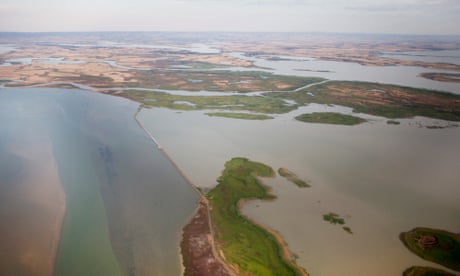- by foxnews
- 08 Apr 2025
‘They’re coming back’: huge flows set to restore life to parched end of Murray-Darling system
‘They’re coming back’: huge flows set to restore life to parched end of Murray-Darling system
- by theguardian
- 14 Nov 2022
- in news

Last week, South Australians were told to brace for Murray River levels not seen in decades.
As water gathers from the wider system and crosses the border into SA, with the peak expected in early December, flows are forecast to reach 165 gigalitres a day, and potentially as high as 220 gigalitres a day. Levels are likely to stay high until February.
Communities are already sandbagging and preparing for possible evacuation. But the water is also doing some good.
The huge amounts of water flowing into the Coorong, lower lakes and Murray mouth are beginning to wash out the salty build-up for the first time since the millennium drought, helping plants, fish and birds recover.
Experts recognise the water is likely to cause damage in SA's Riverland, but say it will provide a much-needed "reset" when it reaches the critical habitats to the south.
Adrienne Rumbelow, the state environment department's Coorong, lower lakes and Murray mouth program leader, says the flows will reset the salinity levels and the ecology.
With fresher water comes more plant life, bugs, worms and crustaceans, and then the birds and fish that feed on them.
"We're always saying we want more water, and now we're getting it," she says. "The more the better for the Coorong, that's where most of the benefit will be."
The Coorong is a Ramsar-listed wetland, and provides critical habitat for a number of species. Rumbelow says with fish monitoring programs are uncovering small bodied, threatened fish species that were "knocked around" during the millennium drought, which was one of the worst ever recorded.
So far researchers haven't spotted more of the invasive carp than usual, but "that might come later", Rumbelow says.
In the meantime, the fish-eating waterbirds are going "gangbusters". There is lots of bird poo on the barrages, indicating that lots of birds are hunting the fish, the pelicans are expected to have a breeding run, and the seals are "looking really obese", she says.
It's only the migratory waders that will have a hard time, Rumbelow says, because they prefer mudflats, and the water might be too high for them.
Matt Gibbs, a CSIRO senior research scientist and hydrologist, says one of the aims of the Murray-Darling Basin plan was to keep the Murray mouth open with no dredging 95% of the time. An open mouth connecting the river and the ocean allows salt and excess nutrients to flow out, which maintains the health of the whole system.
But there has been non-stop dredging since at least 2015, as bickering over the plan continues.
Now, though, enough water is coming through to start to shift sand, and salinity in some parts is the best it's been since 2009.
"That should keep going down for the next couple of months," Gibbs says.
He says the salinity will slowly start to increase again, but "from a better place".
The good conditions might last two or more years before the salinity starts creeping up again, Rumbelow says.
The millennium drought was the trigger for the Murray-Darling Basin plan, which took years to put into place. The plan aims to balance water needs for irrigators in the basin and for the environment. Extra water promised to SA, particularly to save the Coorong, lower lakes and Murray mouth, has split the states.
NSW and Victoria have said they will fail to meet their water saving commitments by 2024.
Some groups are using the excess water currently in the system to argue for the plan to be dumped, even though research consistently predicts increasing droughts.
The SA water minister, Susan Close, says drought is the "more normal condition" in the basin.
"Before Europeans established primary production across the Murray Darling Basin, there was natural flooding periodically and the ecosystems were dependent on that," she says.
"Since we've taken water from the Murray for human use, primary production and cities, those ecosystems have not had that periodic flooding to the same degree.
"This is a natural event that has consequences for people but benefits for the environment. That does not mean we should no longer pursue a sustainable Murray Darling Basin for which drought is the more normal condition."
- by foxnews
- descember 09, 2016
Ancient settlement reveals remains of 1,800-year-old dog, baffling experts: 'Preserved quite well'
Archaeologists have recently unearthed the remarkably well-preserved remains of a dog from ancient Rome, shedding light on the widespread practice of ritual sacrifice in antiquity.
read more


